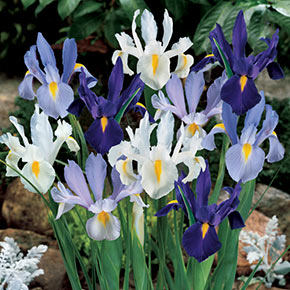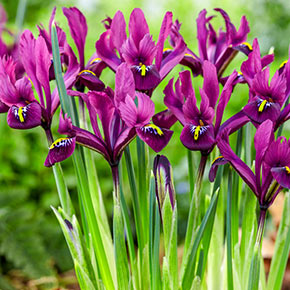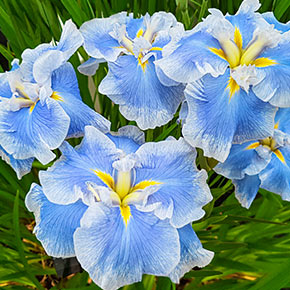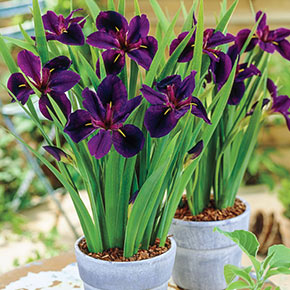-
Spring Planting
Order now for best selections.
-
Fall Planting
Available for preorder for fall 2025 delivery.
-
Bulk Flower Bulbs
Big savings on bulk orders!
- New
-
Gardening Resources
Flower Bulbs & Perennials at Wholesale Prices

How To Plant, Grow and Care For Iris
Growing Bulbous Iris
| Botanical Name | Iris hollandica, Iris reticulata |
| Plant Type | Bulb |
| Sun Exposure | Full sun |
| Soil Type | Well-drained loamy, clay and sandy soils |
| Soil pH | Slightly acidic to neutral |
| Bloom Time | Spring |
| Flower Color | Multicolor, white, yellow, purple, red |
| Hardiness Zones | 4, 5, 6, 7, 8, 9 |
| Special Features | Especially eye-catching when planted en masse |
Rhizomatous Iris
| Botanical Name | Iris germanica, Iris ensata, Iris louisiana, Iris sibirica |
| Plant Type | Rhizome |
| Sun Exposure | Full sun, partial shade |
| Soil Type | Well-drained loamy, clay and sandy soils |
| Soil pH | Slightly acidic to neutral |
| Bloom Time | Varies |
| Flower Color | Multicolor, white, yellow, peach, blue, purple, red |
| Hardiness Zones | 4, 5, 6, 7, 8, 9 |
| Special Features | Gorgeous as cut flowers and very versatile |
Named after the goddess of the rainbow, iris flowers add vibrant color to the spring and summer garden and are simply stunning in cut-flower displays. While these classic perennials are known for their elegant flowers, they're easy to grow and low maintenance. Irises are available in an array of colors, bloom times and sizes. By growing different types, you can enjoy showy iris flowers from early spring through summertime. Bulbous irises, like Dutch Iris, are grown from bulbs, while rhizomatous iris, like German Iris, are grown from rhizomes, or horizontal, root-like structures. Both types are easy to add to your garden. Just follow these tips on how to grow iris and how to care for iris.
Types of Iris
 Dutch: A favorite for cut-flower displays, Dutch Iris have delicate-looking flowers and straplike foliage. Growing 20-24" tall, Dutch Iris bloom in late spring to early summer. These bulbous irises are planted in the fall. Zones 5-9.
Dutch: A favorite for cut-flower displays, Dutch Iris have delicate-looking flowers and straplike foliage. Growing 20-24" tall, Dutch Iris bloom in late spring to early summer. These bulbous irises are planted in the fall. Zones 5-9. Dwarf: Also called Iris reticulata, most Dwarf Iris bloom in late winter to early spring and grow less than 12" tall. These charming bulbous irises are a great way to start iris season and are usually planted in the fall. They can also be forced for indoor blooming. When shopping for dwarf irises, note their botanical name, as some German Iris are available in dwarf sizes. Zones 4-9.
Dwarf: Also called Iris reticulata, most Dwarf Iris bloom in late winter to early spring and grow less than 12" tall. These charming bulbous irises are a great way to start iris season and are usually planted in the fall. They can also be forced for indoor blooming. When shopping for dwarf irises, note their botanical name, as some German Iris are available in dwarf sizes. Zones 4-9. German: Sometimes called Bearded Iris, German Iris are probably the most recognizable iris type. Growing up to 3 ft. tall with swordlike foliage, they bloom in mid to late spring. Their flowers feature prominent beards, or hairs in the center of each fall. Available in a range of colors, these rhizomatous irises can be planted in the spring or the fall. Zones 4-9.
German: Sometimes called Bearded Iris, German Iris are probably the most recognizable iris type. Growing up to 3 ft. tall with swordlike foliage, they bloom in mid to late spring. Their flowers feature prominent beards, or hairs in the center of each fall. Available in a range of colors, these rhizomatous irises can be planted in the spring or the fall. Zones 4-9. Japanese: These beardless iris are often seen enhancing water features. Growing up to 3 ft. tall, Japanese Iris grow best in moist soils. They bloom in the early summer and often have flowers up to 6" across. These rhizomatous irises can be planted in the spring or fall. Zones 4-9.
Japanese: These beardless iris are often seen enhancing water features. Growing up to 3 ft. tall, Japanese Iris grow best in moist soils. They bloom in the early summer and often have flowers up to 6" across. These rhizomatous irises can be planted in the spring or fall. Zones 4-9. Louisiana: A rhizomatous, beardless variety, Louisiana Iris thrives in moist, warm regions—and are also hardy enough to grow in cooler zones. Their gorgeous flowers add color when they burst into bloom in early to midsummer. They're an excellent choice for water gardens or along ponds and streams. They grow up to 3 ft. tall and can be planted in the spring or late summer. Zones 4-10.
Louisiana: A rhizomatous, beardless variety, Louisiana Iris thrives in moist, warm regions—and are also hardy enough to grow in cooler zones. Their gorgeous flowers add color when they burst into bloom in early to midsummer. They're an excellent choice for water gardens or along ponds and streams. They grow up to 3 ft. tall and can be planted in the spring or late summer. Zones 4-10. Siberian: Thriving in colder and temperate regions, these beardless iris bloom in early summer--and each bloom is a work of art. Growing up to 30" tall with straplike foliage, these irises can be grown near water features. A rhizomatous variety, Siberian Iris can be planted in the spring or late summer. Zones 3-9.
Siberian: Thriving in colder and temperate regions, these beardless iris bloom in early summer--and each bloom is a work of art. Growing up to 30" tall with straplike foliage, these irises can be grown near water features. A rhizomatous variety, Siberian Iris can be planted in the spring or late summer. Zones 3-9.
When to Plant Iris Bulbs
Because some Iris grow from rhizomes while others grow from bulbs, pay attention to your iris type when determining when to plant iris bulbs. Bulbous iris, such as Dutch Iris and Iris reticulata, are planted in the fall, after the ground has cooled but several weeks before it freezes. They will then bloom the following spring. Rhizomatous iris, like German Iris, are usually planted in late summer and fall. However, K. van Bourgondien offers some rhizomatous iris for spring planting. These irises come from a grower in the Netherlands where the growing season is slightly different. This makes planting irises in the spring a good option.Where to Plant Irises
When determining where to plant iris, keep in mind that all iris like well-drained soil rich in organic matter and full sun. While irises can grow in partial shade, they may not bloom as profusely. Some Iris, like Japanese, Louisiana and Siberian Iris, are better suited for moister conditions. German Iris are known for being drought tolerant. Iris will grow throughout much of the United States, and depending on the variety, will grow in zones 4-9. However, if you live in a far northern or southern region, pay attention to your grow zone. Some Iris, such as Siberian Iris, do well in cooler regions and will perform as far north as zone 3. Others, like Louisiana Iris, are better suited for warmer regions and will grow as far south as zone 10.How to Plant Iris Bulbs
When planting iris, pay attention to each iris variety's planting instructions. Here's how to plant iris bulbs and rhizomes.When planting iris bulbs, the pointy end should be facing up. Dutch Iris bulbs should be planted about 4" deep and about 3-6" apart. Dwarf Iris (Iris reticulata) bulbs should be planted about 2" deep and 3-4" apart in well-drained soil.
When planting iris rhizomes, the leaves should point up and the roots down. German Iris rhizomes should be planted horizontally so that the top one-third to one-half is above soil level. If growing in a hot climate, plant the rhizomes just below the surface area and grow in partial shade. Japanese, Louisiana and Siberian Iris rhizomes should be planted with their eyes just below the soil. Space the iris rhizomes about 24" apart.
After planting iris bulbs and rhizomes, tamp down the soil and water well.
Materials You'll Need
For digging, you'll need a shovel or trowel. If planting bulbous iris, then an auger and drill makes the job easier. Both the Improved Bulb Auger and KneeSaver Planting Tool are time savers. For bulbous iris, use an all-natural, slow-release fertilizer, like Van Bourgondien 100% Natural Bulb Food, at planting time. For rhizomatous iris, use Van Bourgondien 100% Natural Perennial Food.How to Grow Iris
Bulbous iris plant care: After the flowers bloom, allow the foliage of Dutch Iris and Iris reticulata to fade naturally. The foliage is needed to make food for next year's blooms. Lightly mulching can suppress weeds and provide winter protection.Rhizomatous iris plant care. Do not mulch over the rhizomes. In the spring, fertilize lightly, taking care not to apply fertilizer directly on the rhizome. Generally, the rhizomes can be divided in late summer every 3-5 years. When German Iris flowers have faded, cut back the flowering stem and trim the foliage into a fan shape about 12" tall. In times of drought, water thoroughly.
Iris FAQs
Are Irises Toxic?
While all parts of irises may cause discomfort if ingested, the bulb tends to be the most toxic part. Iris are known to be toxic to pests, and they are deer resistant. When handling iris plants, bulbs and rhizomes, wear gloves to protect your skin from the sap which can be an irritant.What Pests and Diseases Bother Iris?
The Iris Borer is the most common pest. Borers can chew holes in the leaves and burrow into the rhizome, damaging it. Other pests that can damage iris are snails, slugs, whiteflies, aphids and thrips. Good sanitation practices help control pests. After frost in the fall, remove the dead foliage to control pests. Insecticides can also be used. If part of an iris rhizome shows signs of rot, dig up the rhizome and remove the affected section.How Do You Harvest Iris?
Irises make elegant cut-flower displays. To harvest iris, use a sharp cutting tool, knife or pruning shears that will cut the stem without crushing it. Make sure to leave some foliage on the plants.When Do Irises Bloom?
Depending on the variety, irises can bloom from early spring to summer. Dwarf Iris, or Iris reticulata, are the earliest bloomers, while Siberian Iris are summer bloomers.When Do You Divide Irises?
Divide iris plants after they have bloomed and gone dormant in late summer.How Do You Divide Irises?
With a sharp knife, cut the foliage 8-10" above the soil level. Trim the plant into a fan shape. Dig up the clumps and divide with a sharp knife. Discard the oldest (center) part of the rhizome. Check for evidence of disease or iris borers. If found, destroy any infested rhizome. Make sure each new division has a strong root section and single fan of leaves. Dust the cut surface with powdered sulfur and allow to dry for 1-2 days. Replant the horizontal rhizome.How Do You Care for Irises After They Bloom?
Bulbous irises should be treated like other spring flowering bulbs. Allow the foliage to fade naturally before removing it. Rhizomatous or German Iris should be cut back after the flowers have faded. Cut the flowering stem and trim the foliage into a fan shape about 12" tall.How Long Do Iris Blooms Last?
As cut flowers iris blooms usually last 5-7 days. On the plant, some German Iris blooms can stay attractive up to 2 weeks.How Do You Trim Irises After Blooming?
When trimming irises after blooming, always use a sharp set of shears or a knife. Disinfect the blade before use to help reduce the spread of disease.How Do You Transplant Irises?
When transplanting iris rhizomes, make sure the rhizome is leaf side up and root side down. Leave one-half to one-third of the rhizome above the ground. Do not mulch the rhizomes.| Shop All Flower Bulbs | |
| See More Tips |
Have another question? Return to the Customer Service Help page or send an e-mail directly to Customer Service
Copyright © 2025 Gardens Alive!, Inc. d/b/a Dutchbulbs.com. All Rights Reserved. Dutchbulbs.com trademarks are registered trademarks of Gardens Alive!, Inc.
This site is protected by reCAPTCHA and Google Privacy Policy and Terms apply.
This site is protected by reCAPTCHA and Google Privacy Policy and Terms apply.

Item added to cart





